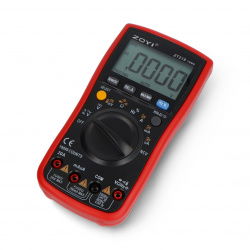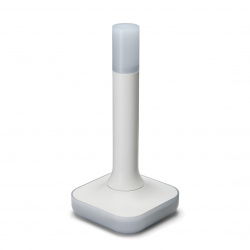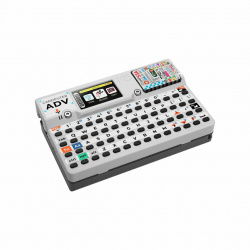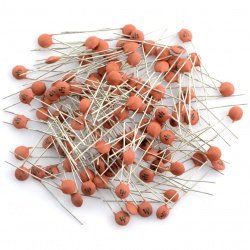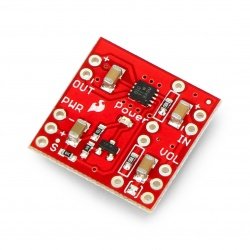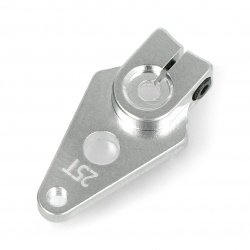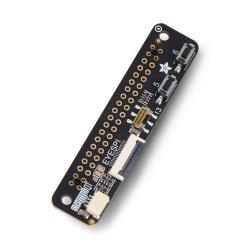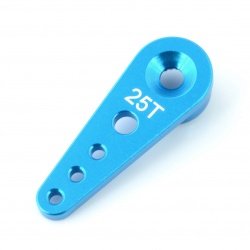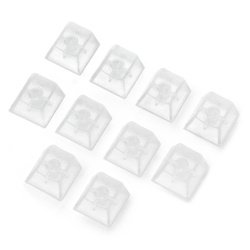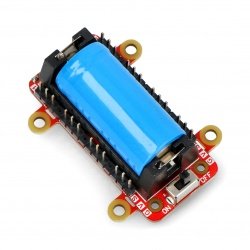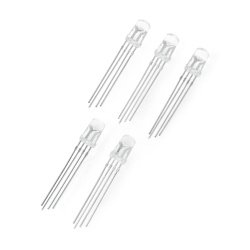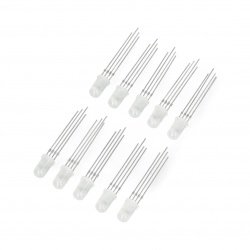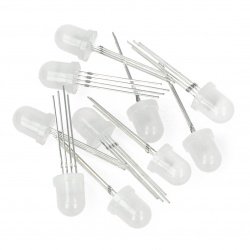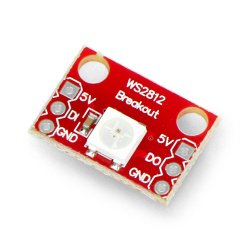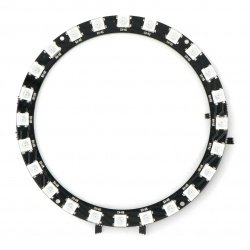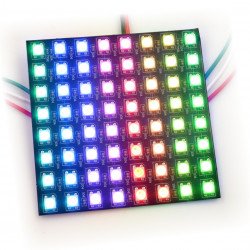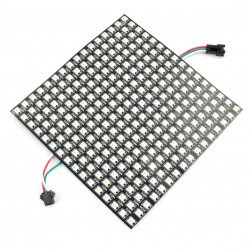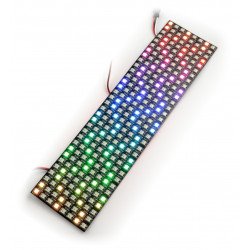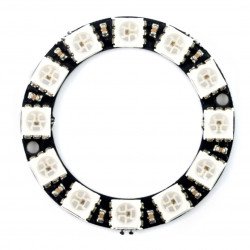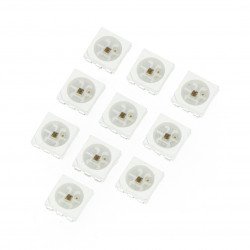Every project should contain an LED diode, and the best solution is a tricolor one! By mixing the colors, for example with a PWM output from a microcontroller, you can get any range of actual colors. An RGB LED is an LED that can light up in three different colors at the same time (red, green, and blue). By letting the base colors light up with different intensities, an RGB LED can light up in many different colors. When it shines at full strength in all colors, the light turns white. When it only glows red, the light also turns red. When it glows both red and green, the light turns yellow. If you want to buy an RGB LED for your project, visit Botland.store. We offer a large selection of high-quality RGB LEDs, and we can assure you that our products will meet your expectations. In this category, you will find items such as LED RGB rings, LED modules for PCB, LED chains, and many more! We provide the best prices and fast delivery.
RGB LED
LED RGB 5mm common anode - 5 pcs
LED RGB 5 mm with common anode. Lens transparent. The product is packed in 5 pieces.LED RGB Ring WS2812 5050 x 16 diodes - 44mm
The ring consists of 16 individually addressed RGB LEDs 5050 with integrated control unit. Module needs one microcontroller output. Outer circle diameter is 44 mm.LED RGB Ring WS2812B 5050 x 24 diodes - 68mm
The ring consists of 16 individually addressed RGB LEDs 5050 with integrated control unit. Module needs one microcontroller output. Outer circle diameter is 68 mm.LED strip RGB WS2812 5050 x 8 LEDs - 53mm
The strip consists of 8 individually addressed RGB LEDs 5050 with integrated driver. To control the module, one microcontroller's pin is sufficient. The module length is 53 mm.Diode LED 5mm RGB WS2811 addressed - 10pcs.
LED 5 mm RGB WS2811 with integrated control unit allows you to control the device via a 1-wire bus.LED RGB Ring WS2812B 5050 x 12 diodes - 50mm
A ring of 12 individually addressable 5050 RGB LEDs with integrated driver. One pin of the microcontroller is enough to operate the module. The outer diameter of the circle is...RGB LED WS2811 8mm addressing - 10pcs
LED RGB 5 mm WS2811 with integrated control unit allows you to control the device via the 1-wire bus.LED RGB 5mm matte common cathode - 5 pcs
LED RGB 5 mm with common cathode. Lens is matte with better light scattering. 5 pcs.Module with addressed RGB LED WS2812
Module with digital addressed diode RGB WS2812 with outputs with the raster of 2.54 mm, for mounting of goldpin connectors (included). It allows you to get any color with a...LED RGB 5mm common cathode - 5pcs.
A single 5 mm led RGB common cathode. Has a transparent lens and shines at an angle of 30°. The color is transferred in three digit RGB (red, green, blue). With these LEDs, you...Ring LED RGB WS2812B 5050 x 24 diodes - 90mm
A ring of 24 individually addressable 5050 RGB LEDs with integrated driver. One pin of the microcontroller is enough to operate the module. The outer diameter of the circle is...Elastic matrix 8x8 - 64 LED RGB - WS2812B individually addressed
The matrix consists of 64 individually addressed RGB LEDs arranged in 8 rows and 8 columns. Each pixel can emit a colour from a 24-bit palette. One microcontroller pin is...Power LED Star 3W LED - RGB with heat sink
Power LED RGB 3W with a heatsink. It allows you to get any color with a mixture of RGB colors.RGB LED Ring WS2812 5050 x 24 LEDs - 66mm
The ring consists of 24 individually addressed RGB LEDs 5050 with integrated control unit. Module needs one microcontroller output. Outer circle diameter is 68 mm.NeoPixel RGBW Mini Button PCB - SK6812 - addressable LEDs - 10pcs. - Adafruit 4776
A set of 10 digital RGBW LEDs SK6812. The diodes can be freely programmed, they accept colour from a 32-bit colour palette: 24 bits RGB and 8 bits white . Recommended...Elastic matrix 16x16 - 256 LED RGB - WS2812B individually addressed
The matrix consists of 256 individually addressed RGB LEDs arranged in 16 rows and 16 columns. Each pixel can emit a colour from a 24-bit palette. One microcontroller pin is...Elastic matrix 8x32 - 256 RGB LED RGB - WS2812B individually addressed
The matrix consists of 256 individually addressed RGB LEDs arranged in 8 rows and 32 columns. Each pixel can emit a colour from a 24-bit palette. One microcontroller pin is...NeoPixel Jewel - ring LED RGB 7xWS2812 5050 - Adafruit 2226
The ring consists of 7 individually addressed RGB LEDs WS2812 5050 with integrated control unit and with holes. Module needs one microcontroller output. Outer circle diameter...NeoPixel Mini PCB - RGB LEDs WS2812 5050 - 5pcs - Adafruit 1612
Modules with individually addressed RGB LED WS2812 24-bit with built-in control unit and with holes. The module needs one microcontroller output. Board sizes: 10 x 8 mm.LED RGB Ring WS2812 5050 x 12 diodes - 38mm
The ring consists of 12 individually addressed RGB LEDs 5050 with integrated control unit. Module needs one microcontroller output. Outer circle diameter is 38 mm.NeoPixel Stick - LED RGB 8 x WS2812 5050 - Adafruit 1426
The panel consists of 8 individually addressed RGB LEDs WS2812 5050 with integrated control unit. The module has one microcontroller output. The length of the panel is 51 mm- Reduced price
- SPECIAL OFFERS
APA102 SMD5050 - set of RGB LEDs with built-in controller - 10pcs
A set of ten individually addressed RGB LEDs SMD 5050 with built-in controller using two-wire communication Protocol SPI.Grove - Variable Color LED v1.1
Module with RGB LED and Grove connector. The color of the LED can be changed by digital signal and PWM, as well as by potentiometers on the board. The module is powered from...Module with LED RGB diode - Iduino SE010
Iduino module with LED diode, emitting light in the colors RGB. It has a 4-pin connector with adjustable input PWM. It can be controlled via the Arduino.See also
RGB diodes shining in any color
The color of an LED's emission depends on its structure, and more precisely, on the semiconductor material from which its PN junction is made. The energy of the photon emitted from the light-emitting diode is determined by the energy gap of the material - this translates into the wavelength of the photon, i.e. its color. As the energy gap in the finished diode cannot be changed, RGB diodes are used to control the color of the emitted light - in a single structure, the system has three diodes - Red, Green and Blue. The RGB color model is an additive model in which red, green, and blue light can be added together to reproduce a wide range of colors.
Controlling RGB LEDs - PWM signal
Light-emitting diodes are controlled by a current signal - it is the current flow, not the applied voltage, that causes the electroluminescence of the PN junctions in the LED. While current stabilization is simple, digital control is more complex. Therefore, PWM controllers are used to control the brightness of LEDs instead of digitally regulated current sources. Such systems modulate the current flowing through the diode with a square wave signal with variable duty cycle. By regulating the percentage of time the LED is on, the brightness is regulated - the LED is turned on and off so quickly that human eyes do not notice the blinking, but only the average emission intensity at a given moment.
Addressable RGB LEDs with built-in drivers
RGB LEDs with an integrated controller are an intelligent light source that can be digitally controlled. In addition to three LEDs, an addressable three-channel LED controller is also integrated in a single element. It has a digital input that allows you to transmit data and control the relative brightness of each of the integrated LEDs. Moreover, these elements can be cascaded together. Each driver has a 24-bit shift buffer that controls the brightness of each LED (eight bits per LED). Subsequent data transferred to the element via the serial interface is sent to the next diode using only one GPIO line, e.g. a microcontroller or a single-board computer.
RGB LEDs - FAQ
The RGB diode is nothing more than a combination of three LED structures (red - R ed, green - G reen and blue - B lue) within one housing. RGB LEDs come in various varieties, including through-hole (THT) and surface-mount (SMD) diodes, and as elements of larger LED modules.
Depending on the design, the anodes or cathodes of all three "component diodes" are connected together and led outside the housing (we are then talking about a diode with a common anode or a common cathode, respectively). The anode (or anodes) should be connected to a higher potential (e.g. the positive pole of the battery), and the cathode (or cathodes) should be connected to a lower potential. Please remember that each of the "channel" terminals (R, G, B) should be powered by a series current-limiting resistor .
































































































































































































































































































































